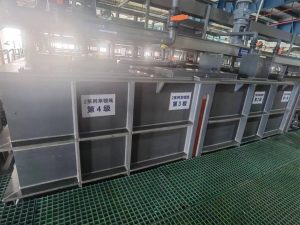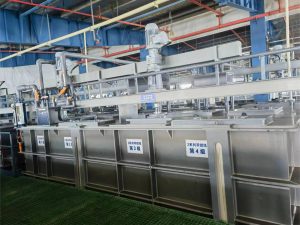Ethanol, hexane, acetone, dichloromethane, and ethyl acetate excel in extraction for their solvency, cost-effectiveness, and efficiency.
Ethanol
Features and Benefits
Ethanol, is a solvent used in various extraction processes. Since ethanol has a dipole charge, it is also polar, so both polar and non-polar solvents can be extracted with it. Ethanol is also relatively safe, non-toxic, and has a low boiling point of 78.37°C, so it can be exuded without much effort after extraction.
For example, ethanol is used in various extraction procedures related to extracting herbal ingredients and essential oils due to its wide range of phytochemical solubility.
Food and Pharmaceutical Applications
The food industry uses ethanol to extract flavors, colors, and active ingredients from natural sources. A common example is the extraction of vanilla from vanilla beans, where both flavor and aroma compounds can be extracted by ethanol.
An important use of ethanol in pharmaceuticals is for the preparation of tinctures, extracts, or medicinal compounds. It is used to collect active secondary metabolites such as alkaloids and glycosides from plants, which are then used to make many formulations.
Quantitative Analysis: The use of ethanol for pharmaceutical extraction produces 90% efficiency in isolating active compounds, ensuring that the produced pharmaceutical products are of excellent quality.
Environmental sustainability
Its main advantages are that it is biodegradable and can be produced from renewable resources such as corn, sugar cane and other biomass, making it an attractive “green” solvent. The carbon footprint of UVFILMS production and use is lower than that of petrochemical solvents.
For example, ethanol made from sugar cane in Brazil has a carbon footprint 90% lower than gasoline, thus making it a more sustainable energy option that can also be used in industrial settings.
Safety and handling
Basic description: Ethanol is non-toxic, but flammable and an irritant, so it should be used with care. To avoid fire hazards, the material must be stored in a well-ventilated area and safe behavior must be observed.
For example, under laboratory conditions, ethanol should be stored in a fireproof cabinet and used in accordance with personal protective equipment (PPE) requirements such as gloves and goggles.
Cost and availability
It is readily available and fundamentally low-priced, making it the lowest cost of all extraction methods. The scalability of graphene-type production provides a stable supply, especially for industrial use.
Quantitative Insights: At less than $1 to $3 per liter, depending on the quality and source of the alcohol, ethanol is an economical feedstock for pilot and industrial-scale implementation.
Hexane
Features and Benefits
Hexane is a polar solvent that is very active in the dissolution process of oils and other non-polar compounds. It has a low boiling point of about 69°C, so it is easily removed by evaporation after the extraction process. Hexane is a very good solvent for extracting oils from seeds and other plant materials.
Example: Hexane is a byproduct of gasoline production, and the extraction of vegetable oils from seeds such as soybeans, its low boiling point (69ºC) and ability to effectively dissolve lipids can produce high-quality oils.
Oil Extraction Applications
Hexane is often used as a solvent in the cold pressing of oilseeds and grains, where cheaper, lower quality products can be consumed. Solvent extraction using hexane can extract up to 98% of the oil, which is much more efficient than mechanical pressing methods.
Example: In the soybean oil production process, hexane extraction is used to extract oil from soybean flakes. In the extractor, the flakes are mixed with hexane to dissolve the oil from the solid material. The hexane is then boiled off, leaving an oil-hexane mixture from which pure soybean oil is recovered.
Quantitative Perspective: Hexane extraction yields over 95% oil, while mechanical pressing yields about 75%
Safety and Handling
Recommendations: Hexane is flammable and steps should be taken to prevent inhalation or ingestion. Adequate ventilation and appropriate personal protective equipment are required when handling hexane to reduce the risk of exposure and accidents.
Example: Hexane is used in industrial settings and should be used in a well-ventilated environment and requires the use of gloves, goggles, and a respirator. Sealed Containers Hexane is stored in sealed containers away from hot surfaces and sources of ignition.
Environmental Impact
Hexane is made from petroleum, so it is far from the most environmentally friendly option. It is a process that is harmful to the environment in terms of air and water unless handled properly. Therefore, it is also important to take steps to reduce its environmental impact, such as controlling hexane emissions and improving solvent recovery and recycling.
For example, solvent recovery systems can capture and recycle up to 99% of the hexane used in the extraction process, reducing emissions and environmental pollution.
Cost and Availability
Hexane is cheap and abundant, which is why it is a common punctuation mark in large-scale extractions. Industrial use can ensure a reliable supply of material due to its large-scale availability.
Quantitative Note: Hexane is inexpensive, typically costing between $1.00 and $2.00 per liter, making it an affordable option for high-volume, non-polar extractions such as petroleum.
Performs well in many extraction processes
The call for hexane in this case should not be questioned, as it is also used in some petroleum extraction and pharmaceutical operations to extract other active ingredients from plant materials. However, it can only dissolve non-polar compounds, making it a versatile solvent in many applications in addition to being a good solvent for food production.
For example, in the extraction of essential oils and spices, hexane is needed to remove non-polar aromatics from flowers and leaves, resulting in a pure extract suitable for incorporation into perfumes and aromatherapy preparations.

Acetone
Features and Benefits
Acetone is a volatile solvent with a boiling point as low as 56°C. This is why it is a great solvent as it has a high solubility for a wide range of different organic compounds (polar and non-polar). Acetone is a highly volatile chemical with low toxicity and evaporation rates compared to other industrial organic solvents.
Example: Acetone is often used in laboratories to extract organic compounds as it can dissolve a wide range of compounds very quickly and efficiently.
Industrial and Laboratory Applications
Acetone is widely used in industrial and laboratory settings for extraction procedures, and this ability allows it to dissolve many different compounds very well, making it an ideal solvent for a wide range of uses.
Application: Example in the pharmaceutical industry where acetone is used to isolate active ingredients from botanical raw materials. Since the solvent dissolves substances very quickly, it is able to extract the target molecules from these processes, which can then be made into drugs.
Quantitative Insight: Acetone extractions can achieve >95% purity and maintain high SFE yields, resulting in high quality of the isolated active pharmaceutical ingredient.
Safety and Handling
Compared to many other solvents, acetone is less hazardous to health, has relatively low toxicity, and is suitable for use despite being flammable. Proper storage in ventilated areas and use of protective equipment to avoid fire and health risks are not luxuries, but musts.
Example: In a laboratory setting, acetone should be used in a fume hood to avoid inhalation of vapors and appropriate personal protective equipment such as gloves and goggles should be worn.
Environmental Impact
Compared to many other solvents, acetone is biodegradable and has a low toxicity/environmental impact. Nonetheless, large-scale commercial utilization must implement safeguards to prevent excessive emissions and contamination.
Example: Solvent recovery systems in the chemical manufacturing industry can capture and recycle over 95% of the solvent, minimizing the environmental impact of acetone emissions.
Cost and Availability
A significant advantage of acetone is that it is very common and inexpensive, making it a common-sense choice for many (many) extraction procedures. This is why it is used as a solvent in industry and research due to its low cost and availability.
Quantitative Insight: Due to purity and the volume purchased, acetone is typically priced at $0.50-1.50 per liter, making it a cost-effective choice for industrial-scale operations.
Effectiveness of various extraction processes
As a raw material for various industrial processes, acetone is widely used not only to isolate active ingredients in pharmaceuticals, but also in the production of plastics, fibers, pharmaceuticals and other chemicals. It can be further used for cleaning and degreasing as it evaporates too quickly and has good washing capabilities.
Including use in plastic production – as a cleaning solvent and in the coatings industry, such as removing resin/ink residues from equipment) This highlights how acetone is used in the manufacturing process to ensure quality standards are met.

Dichloromethane
Features and Benefits
Dichloromethane (DCM), or methylene chloride, is a volatile, colorless liquid with a boiling point of 39.6 °C and is one of a growing number of solvents that have been thoroughly tested and characterized in the lab. Due to its highly non-polar nature, DCM is a very effective solvent for dissolving organic materials. It has a high evaporation rate; it is able to combine polar and non-polar substances together.
For example, it is a common solvent for caffeine extraction in the process of making decaffeinated coffee, and DCM is one of the solvents that dissolves caffeine without chemically reacting with the substance.
Applications through Decaffeination and Chemical Reactions
DCM is used to extract caffeine from coffee and tea during late night recording sessions and all-night bar roasts. This selective caffeine-dissolving solvent property allows for efficient caffeine removal without unduly affecting the flavor or quality of the product.
For example, to decaffeinate using the direct solvent method, coffee beans are first soaked in water and then washed with DCM to dissolve the caffeine. These beans are then air-dried to create decaffeinated coffee, in which the flavor of the coffee is largely retained.
Quantitative perception: This DCM-based technology can remove up to 98% of caffeine, and it is certain that the caffeine removal rate of this process is very high.
Safety and handling
DCM is a volatile organic compound (VOC), so due to its toxicity and health risks, it needs to be handled properly and carefully. Good ventilation and personal protective equipment are required to reduce exposure.
Example: In industrial settings, DCM should be used in well-ventilated areas with fume extraction systems. Personal protective equipment (PPE) work, such as gloves, goggles and masks used by workers; deployed to prevent inhalation and skin contact.
Environmental impact
DCM is not very friendly to the environment because it causes air and water pollution. In addition to efforts to clean emissions and prevent pollution, it is also key to reduce its harmful effects on the surrounding environment.
Example: Industrial applications of DCM can capture and recover slowly evaporated DCM during process operations to prevent its release into the atmosphere and environment. Although the environmental impact is reduced, especially if this can result in a recovery rate of 90% or more.
Cost and Availability
Due to its wide availability and relatively low cost, DCM is easily purchased and therefore widely used in chemical syntheses and laboratories. Since it is cheap and economical, this makes it an ideal solvent for large-scale extractions.
Quantitative Insight: The cost of DCM is typically between $2 and $4 per liter, depending on the purity and quantity purchased, providing an economical solution for many extraction processes.
Effectiveness of Various Extraction Processes
In addition to its use in decaffeination, DCM is also used in the pharmaceutical industry to extract active ingredients from raw materials. Since it can dissolve many different compounds, it can be used in a variety of chemical syntheses and extractions.
For example: The pharmaceutical industry uses DCM to extract and purify active pharmaceutical ingredients (APIs) from raw materials of plant origin. Its ability to dissolve complex organic molecules allows the output to be clean with good yield and purity.
Ethyl Acetate
Features and Benefits
Ethyl acetate is a colorless solvent with a sweet (pear-like) flavor and a boiling point of 77.1°C. It dissolves a wide range of organic compounds, making it an excellent solvent for many extraction procedures. Ethyl acetate produces a high heat differential and produces an offensive odor, but is safer from a toxicological standpoint, making it ideal for use in industrial and laboratory settings.
For example, ethyl acetate is widely used in the food industry for the purification of flavors and fragrances due to its ability to completely dissolve natural oils and aromatic compounds.
Food Processing and Spice Extraction
Ethyl acetate is often used to extract flavors and fragrances from natural sources. It effectively dissolves essential oils, making it a popular choice for producing high-quality extracts used in food and cosmetics
For example, vanilla extract is used to dissolve the essential oils in tonka beans, which give vanilla its flavor, using ethyl acetate. Finally, the solvent is removed, leaving behind the vanilla extract.
Quantitative Insights: Utilize ethyl acetate to reduce essential oil separations to achieve higher purity (up to 95%) for the production of high-quality flavor and fragrance end products.
Safety and Handling
Although ethyl acetate is a weaker solvent than many others, it is still very flammable and must be handled with care. So take the necessary safety precautions like storing safely in an overhead ventilated space and wearing a mask and you can have fun.
Laboratory Example: Ethyl acetate should be stored in a fireproof cabinet in the laboratory and gloves and goggles must also be worn when using it and only authorized personnel are allowed to use it.
Environmental Impact
Ethyl acetate is a biodegradable and environmentally friendly organic solvent. They have such applications that they can be used in certain industrial processes and even minimize pollution, which is an environmentally friendly solution.
Example: In the production of flavor compounds, ethyl acetate is used in the production of flavor compounds and its biodegradability works in that it degrades easily in the environment, thereby minimizing the possibility of long-term pollution.
Cost and Availability
Since ethyl acetate is easily available and relatively cheap, it is an ideal solvent for many extraction processes. With these characteristics, it is a low-cost, efficient solvent suitable for both small and large-scale businesses.
Quantitative Insight: The price of ethyl acetate is usually in the range of $1-3/liter, depending on the purity and quantity purchased, which makes it a cost-effective extraction method.
Efficiency of Different Extraction Techniques
Besides being used to extract flavors and fragrances, ethyl acetate is also used in the pharmaceutical industry to separate active ingredients. Its solubility means it can be used for more than just processed foods.
In the pharmaceutical industry, for example, ethyl acetate is often the first choice for isolating and refining active pharmaceutical ingredients (APIs) from plant raw materials. This maintains the purity of the final product, which is top quality.
Quantitative results: API purities of more than 90% can be achieved using the ethyl acetate extraction method, making ethyl acetate a good solvent for pharmaceutical uses.
